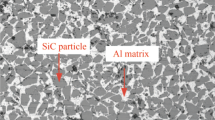Abstract
The current research study for hybrid machining of Al-based metal matrix composites (MMCs) employs magnetic field coupled traditional electrical discharge machining (EDM) to address the manufacturing demands in aeronautics, automobile, medical equipment, etc. The input processing parameters, for instance, magnetic field intensity, pulse-on/off duration, peak current, variant of electrodes as well as workpiece were evaluated to determine their after-effects on the responses in terms of microhardness (MH) and recast layer formation while machining of Al-SiC composites. The experimental results show 22% decrease in the surface microhardness values and thinner recast layer formation at magnetic field coupled higher spark energy. The results demonstrate the process stability and exhibit a good accord with experimental verification.
Similar content being viewed by others
Abbreviations
- CNC:
-
Computer Numeric Control
- MRR:
-
Material Removal Rate
- dB:
-
decibels
- MH(HV):
-
Microhardness (Vickers Pyramid Number)
- TWR:
-
Tool Wear Rate
- MFAEDM:
-
Magnetic Field Assisted Electrical Discharge Machining
- RC:
-
RECAST
- B(T):
-
Magnetic Field (tesla)
- EDM:
-
Electrical Discharge Machining
- I(A):
-
Current (amperes)
- W/P:
-
Workpiece
- R1:
-
Repetition-1
- R2:
-
Repetition-2
- DF:
-
Degrees of Freedom
- Seq SS:
-
Sequential Sums of Squares
- Adj SS:
-
Adjusted Sums of Squares
- Adj MS:
-
Adjusted Mean Square
- p-value:
-
Probability
- Al-SiC:
-
Aluminum-Silicon Carbide
- J (vector quantity):
-
Current density
- F (vector quantity):
-
Lorentz Force
References
Bains PS, Sidhu SS, Payal HS (2015) Fabrication and machining of metal matrix composites: a review. Mater Manuf Process 31:553–573
Yan BH, Chang GW, Chang JH, Hsu RT (2004) Improving electrical discharge machined surfaces using magnetic abrasive finishing. Mach Sci Technol 8:103–118
Sidhu SS, Batish A, Kumar S (2014) Study of surface properties in particulate-reinforced metal matrix composites (MMCs) using powder-mixed electrical discharge machining (EDM). Mater Manuf Process 29:46–52
Yeo SH, Murali M, Cheah HT (2004) Magnetic field assisted microelectro-discharge machining. J Micromech Microeng 14:1526–1529
Rattan N, Mulik RS (2017) Experimental investigations and multi-response optimization of Silicon dioxide (Quartz) machining in magnetic field assisted TW-ECSM process. Silicon 1–11
Yamaguchi H, Shinmura T (2004) Internal finishing process for alumina ceramic components by a magnetic field assisted finishing process. Prec Eng 28:135–42
Hagelaar GJM (2007) Modelling electron transport in magnetized low-temperature discharge plasmas. Plasma Sources Sci Technol 16:S57
Lin YC Lee HS (2008) Machining characteristics of magnetic force-assisted EDM. Int J Mach Tool Manu 48:1179–1 186
Chattopadhyay KD, Satsangi PS, Verma S, Sharma PC (2008) Analysis of rotary electrical discharge machining characteristics in reversal magnetic field for copper-en8 steel system. Int J Adv Manuf Technol 38:925–937
Joshi S, Govindan P, Malshe A, Rajurkar K (2011) Experimental characterization of dry EDM performed in a pulsating magnetic field. CIRP Ann Manuf Technol 60:239–242
Griffiths DJ (1999) Reed College. Introduction to electrodynamics, vol 3. Prentice Hall, Upper Saddle River
Heinz K, Kapoor SG, DeVor RE, Surla V (2011) An investigation of magnetic-field-assisted material removal in micro-EDM for nonmagnetic materials. J Manuf Sci E T ASME 133:021 002
Bains PS, Sidhu SS, Payal HS (2016) Study of magnetic field assisted ED machining of metal matrix composites. Mater Manuf Process 31:1889–1894
Taguchi G (1990) Introduction to quality engineering. Asian Productivity Organization, Tokyo
Holmberg J, Wretland A, Berglund J (2016) Grit blasting for removal of recast layer from EDM process on Inconel 718 Shaft: an evaluation of surface integrity. J Mater Eng Perform 25:5540–5550
Acknowledgements
The authors would like to express special thanks to IKG Punjab Technical University, Kapurthala for supporting this research work.
Author information
Authors and Affiliations
Corresponding author
Rights and permissions
About this article
Cite this article
Bains, P.S., Sidhu, S.S. & Payal, H.S. Magnetic Field Assisted EDM: New Horizons for Improved Surface Properties. Silicon 10, 1275–1282 (2018). https://doi.org/10.1007/s12633-017-9600-7
Received:
Accepted:
Published:
Issue Date:
DOI: https://doi.org/10.1007/s12633-017-9600-7




